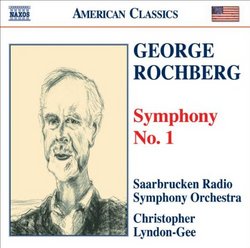| All Artists: George Rochberg, Christopher Lyndon-Gee, Saarbrucken Radio Symphony Orchestra Title: George Rochberg: Symphony No. 1 Members Wishing: 0 Total Copies: 0 Label: Naxos American Release Date: 10/30/2007 Genre: Classical Style: Symphonies Number of Discs: 1 SwapaCD Credits: 1 UPC: 636943921425 |
Search - George Rochberg, Christopher Lyndon-Gee, Saarbrucken Radio Symphony Orchestra :: George Rochberg: Symphony No. 1
 | George Rochberg, Christopher Lyndon-Gee, Saarbrucken Radio Symphony Orchestra George Rochberg: Symphony No. 1 Genre: Classical
|
Larger Image |
CD Details |
CD ReviewsAn Early Rochberg Symphony on Naxos Robin Friedman | Washington, D.C. United States | 11/06/2007 (5 out of 5 stars) "The American composer George Rochberg (1918- 2005) is best-known for his turn from serial (atonal) composition to a "hard" romantic, tonal style following the success of his 1955-1956 Second Symphony, a lengthy passionate work composed atonally. Over the past several years, Christopher Lyndon-Gee and the Saarbrucken Radio Symphony Orchestra have offered music lovers an excellent opportunity to get to know Rochberg's orchestral music on the "American Classics" series of the budget-priced Naxos label. In addition to the atonal Second Symphony, Lyndon Gee has offered outstanding readings of Rochberg's latter music, including the violin concerto and the Fifth Symphony. He has also written perceptive liner notes to accompany the music. I have enjoyed getting to know Rochberg's music throught these recordings.
The latest recording from Lyndon-Gee in the series is this recently-released CD of Rochberg's early Symphony No. 1. Rochberg first composed this symphony as a young man of 31 in 1948-1949. It is a large, outsize five-movement work of over one hour in length. It was first conducted by Rochberg and a student orchestra of the Curtis Institute of Philadelphia in 1949. Eight years later, Eugene Ormandy conducted a much-abridged version which led to a falling out between Ordmandy and the composer. The work has not been performed a great deal since Ormandy's attempt, and this is its first recording. Significantly, Rochberg returned to the symphony twice, making major edits in 1977 and again in 2003 in preparation for this recording. Thus this recording presents an early work, but one substantially revised by a mature composer who had found his musical voice. The First Symphony is not composed in the serial style that Rochberg adopted for the Second Symphony and subsequently abandoned. In hearing the opening bars, my first thought was of Aaron Copland, whom Lyndon-Gee does not mention in his opening notes. (He discusses instead the influence of both Stravinsky and Schoenberg.) The work is in five movements with the two outer movements predominantly brassy and loud -- the finale repeats some of the material of the opening movement. The second and fourth movements are slow movements. The second is captioned "Night Music" and is highlighted by a cello solo midway. The fourth movement, the longest of the work, is a set of variations on a renaissance-style theme which Rochberg revised greatly in 2003. The central movement is a quirky, scherzo-like capriccio. Listeners familiar with Lyndon-Gee's other recordings will recognize Rochberg in this music. The work shows the same mix of romanticism and tautness that characterize his later compositions as well as the Second Symphony. From listening to these recordings, I think Rochberg's changes over the years were in musical language -- going from atonality to tonality --but the range of feelings and emotions, and the characteristics of the music in whatever idiom remain remarkably constant. The first, as is much of Rochberg's music, includes striking orchestration in which passages for full orchestra alternate with concertante passages for solo instruments -- the cello, winds, percussion and piano all get their solo moments in the First Symphony. In addition, each individual movement goes through a variety of tempos and moods. The slow movements both have contrasting sections, as do, from the other direction, the opening and closing movements. The opening movement has a quiet section near the end, while the finale, continuing the mood of the variation movement, opens slowly and pensively before picking up in liveliness to a surprising abrubt close. The cappricio wanders all over in moods and tempo. Rochberg's first is a ambitious, sprawling, lengthy symphony which receives what will likely be its definitive performance in this recording. Lyndon-Gee and Naxos continue to perform a wonderful service in making Rochberg's music accessible to listeners wishing to explore the American experience in art music. Robin Friedman" |

 Track Listings (5) - Disc #1
Track Listings (5) - Disc #1